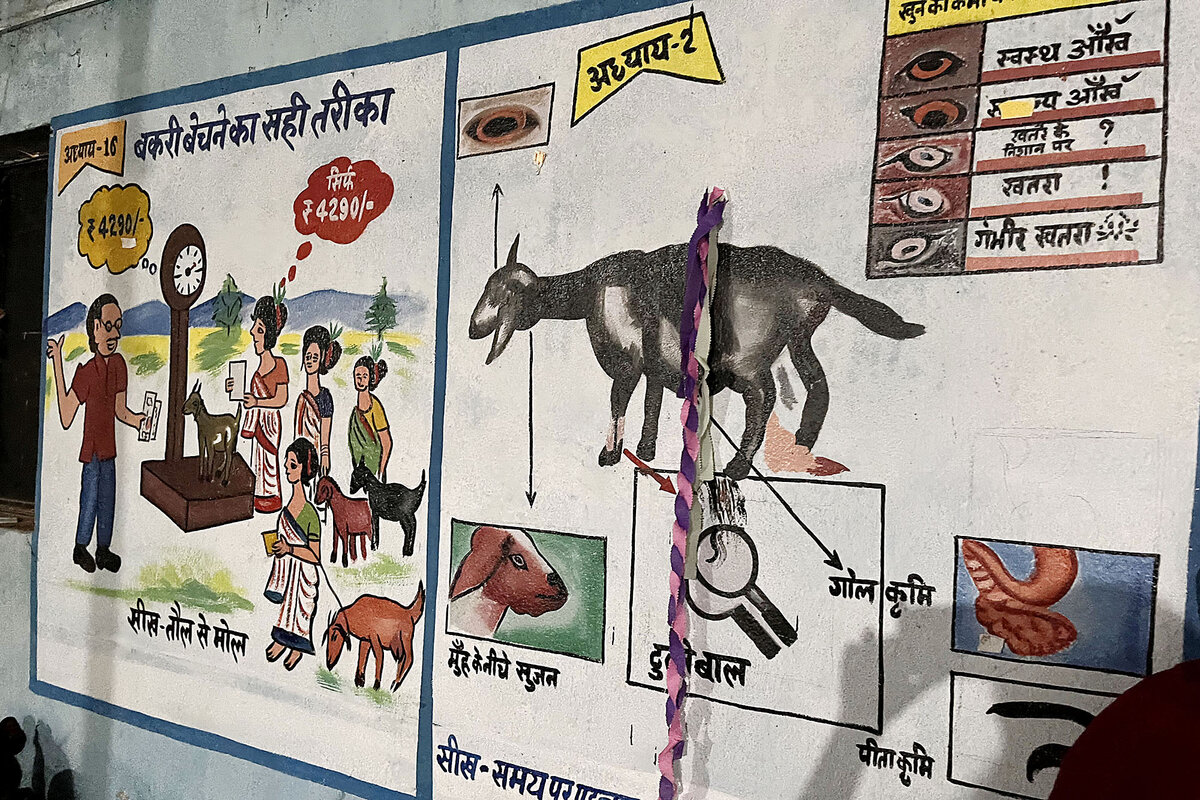The kids are all right: How rural India’s ‘goat nurses’ help animals – and themselves
Loading...
| Getalsud, India
India is home to one-sixth of the world’s goat population. Although these creatures can be a critical source of income for families, poor access to veterinary services and owners’ limited knowledge of animal health led to high mortality and morbidity rates.
But results from one novel initiative indicate the tide may be turning.
Why We Wrote This
A story focused onIn rural India, a goat is a valuable asset. For the women who have been trained to care for them, they’re also a path to greater dignity and respect.
The Pashu Sakhi, or “friend of the animal,” program works to fill gaps in veterinary care by transforming rural, semiliterate women into animal health care workers. With support from the Indian government, around 60,000 women across India have been trained to respond to medical emergencies and provide services like deworming and vaccination, leading to a spurt in goat populations in several states, say program coordinators.
Goat mortality in the Jharkhand, for example, was once 50%; authorities now report that figure is below 15%.
Livestock owners pay a fixed sum for each service, and “goat nurses” also receive a small stipend from the government. But there’s a less tangible outcome, too – the building up of women’s self-esteem and independence.
Basmati Devi says that being a wife was once her only identity. “People used to know me by my husband’s name,” she says. “Now they know me as a goat nurse, and it feels good.”
Dressed in a light-blue sari, Ritmani Devi cradles two black baby goats as she guides a flock of ducks toward its coop. The birds scurry between the legs of an older goat, quacking nonstop.
A few years ago, this muddy yard was much less lively. Ritmani Devi’s goats would often die, she says, and the ones that survived weren’t very healthy. This was common here in the east Indian state of Jharkhand and throughout the country.
India is home to one-sixth of the world’s goat population. A goat is a valuable asset for a low-income family, ready to be sold at a moment’s notice in case of emergencies. But with owners lacking basic animal health knowledge, that’s all they were – a one-time, last-ditch safety net, rather than an alternative stream of income. Plus, poor access to veterinary services led to high mortality and morbidity rates among goats.
Why We Wrote This
A story focused onIn rural India, a goat is a valuable asset. For the women who have been trained to care for them, they’re also a path to greater dignity and respect.
Now, results from one novel initiative that began a decade ago indicate the tide may be turning. The Pashu Sakhi, or “friend of the animal,” program works to fill gaps in veterinary care by transforming rural, semiliterate women into community animal health care workers, or “goat nurses.” With support from the Indian government, the World Bank, the Gates Foundation, and others, around 60,000 women across India have been trained to provide services like vaccination and deworming, leading to a spurt in goat populations in several states. They are paid for the care they provide, and gain a sense of pride and independence.
For Basmati Devi – who is not related to Ritmani Devi, but like many women in Jharkhand uses Devi (meaning “goddess”) like a surname – being a wife was once her only identity. “People used to know me by my husband’s name,” she says. “Now they know me as a goat nurse, and it feels good.”
Goat nurses to the rescue
At the community hall near Ritmani Devi’s home in Getalsud village, the walls are painted with training material, including illustrations of common symptoms to look out for, like swelling under the animal’s mouth or pale eyes, and tips on how to negotiate better rates for goats in the market.
Jharkhand was one of the first states in India to adopt the Pashu Sakhi model. Having women at the forefront of the initiative was a natural choice, says Swadesh Singh, a livestock specialist at the Jharkhand State Livelihood Promotion Society, the government agency that runs the program.
In rural India, the responsibility of managing small ruminants and poultry usually falls on women. Meanwhile, veterinary doctors – who sometimes serve multiple village clusters alone – focus on larger, more valuable animals like cows and buffalo. Before the program, goat mortality in Jharkhand was 50%, says Dr. Singh.
Authorities say that figure is now below 15% – thanks in large part to the state’s goat nurses.
The typical Pashu Sakhi candidate has at least eight years of schooling. After being selected by the state’s livestock department, they’re taught how to administer vaccines, what type of fodder is best for the animals, and how to give preventative care. More advanced nurses also get trained in managing disease, performing castration, goat breeding and marketing, and more.
Goat nurses are often the first responders in any livestock-related medical emergency, in addition to conducting regular check-ups and advising others on goat rearing. Their proximity is a huge advantage. Hailing from the same community that they serve makes it easier to build trust, and the women can take on as much work as they like.
Livestock owners pay a fixed sum for each service – about 12 cents for every vaccination, for example – and goat nurses also receive a small stipend from the government. Ahilya Devi says she makes anywhere from $25 to $85 a month. That money goes toward her children’s school fees, groceries, and other household expenses – and, occasionally, a personal treat like makeup.
“Earlier, I had to consult my husband for every expense,” she says, “but now if I want to buy something, I don’t hesitate.”
Empowering women through goats
To be sure, the work comes with challenges. Farmers are often reluctant to pay for services, says Dr. Singh, and there’s the risk that goat nurses may be threatened or harmed if an animal dies under their care. In an essay about the Pashu Sakhi program, Observer Research Foundation senior fellow Arundhatie Biswas Kundal emphasized the need to “provide the women with adequate protection and aid them in registering complaints.”
Still, the initiative has paid rich dividends. In some districts of Bihar, Maharashtra, and Haryana, goat mortality fell to single digits. Between 2012 and 2019, Jharkhand’s goat population – which had become stagnant – grew by nearly 40%, and another livestock census is expected to take place this year. Spurred by the program’s success, goat nurses in some parts of Jharkhand are also being trained to cater to larger animals like cattle, says Dr. Singh.
Armed with knowledge about animal rearing, some goat nurses, like Ritmani Devi, have channeled their training into increasing the size of their own herd. She now has 14 goats.
There’s also a less tangible outcome. The initiative has contributed to “the building of social capital and self esteem” among urban women, wrote Dr. Kundal. People often refer to the goat nurses as “doctor didi,” meaning an elder sister or person you think highly of. And empowering women has the potential to improve other developmental indices, argues Dr. Singh. “When a woman earns something extra, she always invests it in her children’s nutrition and their education,” he says.
But none of this happens overnight. When Ahilya Devi first started as a goat nurse, people would look at her with some suspicion.
“Even those from my own village did not recognize me, because I did not step out of the house much,” she says.
Now, nearly a decade later, they welcome her into their homes with respect.









